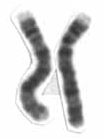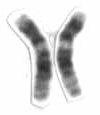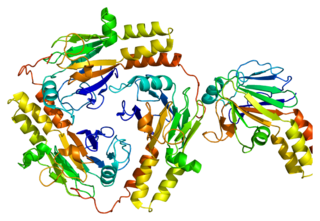| Look up tribble or tribbles in Wiktionary, the free dictionary. |
Tribble or tribbles may refer to:
| Look up tribble or tribbles in Wiktionary, the free dictionary. |
Tribble or tribbles may refer to:
| This disambiguation page lists articles associated with the title Tribble. If an internal link led you here, you may wish to change the link to point directly to the intended article. |

Star Trek: The Animated Series (TAS), originally airing as Star Trek and as The Animated Adventures of Gene Roddenberry's Star Trek, is an American animated science fiction television series created by Gene Roddenberry. It originally aired from September 8, 1973, to October 12, 1974, on NBC, spanning 22 episodes over two seasons. The second series in the Star Trek franchise, it is the first sequel to Star Trek: The Original Series. Set in the 23rd century, when Earth is part of a United Federation of Planets, it follows the adventures of the Starfleet vessel USS Enterprise as it explores the Milky Way galaxy.

David Gerrold is an American science fiction screenwriter and novelist. He wrote the script for the original Star Trek episode "The Trouble with Tribbles", created the Sleestak race on the TV series Land of the Lost, and wrote the novelette "The Martian Child", which won both Hugo and Nebula Awards, and was adapted into a 2007 film starring John Cusack.

"The Trouble with Tribbles" is the fifteenth episode of the second season of the American science fiction television series Star Trek. Written by David Gerrold and directed by Joseph Pevney, it was first broadcast on December 29, 1967. In this comic episode, the starship Enterprise visits a space station that soon becomes overwhelmed by rapidly-reproducing small furry creatures called "tribbles".
CAMK, also written as CaMK, is an abbreviation for the Ca2+/calmodulin-dependent protein kinase class of enzymes. CAMKs are activated by increases in the concentration of intracellular calcium ions (Ca2+) and calmodulin. When activated, the enzymes transfer phosphates from ATP to defined serine or threonine residues in other proteins, so they are serine/threonine-specific protein kinases. Activated CAMK is involved in the phosphorylation of transcription factors and therefore, in the regulation of expression of responding genes. CAMK also works to regulate the cell life cycle (i.e. programmed cell death), rearrangement of the cell's cytoskeletal network, and mechanisms involved in the learning and memory of an organism.

"Trials and Tribble-ations" is the 104th episode of the American science fiction television series Star Trek: Deep Space Nine, the sixth episode of the fifth season. It was written as a tribute to the original series of Star Trek, in the 30th anniversary year of the show; sister series Voyager produced a similar episode, "Flashback". The idea for the episode was suggested by René Echevarria, and Ronald D. Moore suggested the link to "The Trouble with Tribbles". The two were credited for their work on the teleplay, with the story credit going to Ira Steven Behr, Hans Beimler, and Robert Hewitt Wolfe.

Chromosome 4 is one of the 23 pairs of chromosomes in humans. People normally have two copies of this chromosome. Chromosome 4 spans more than 186 million base pairs and represents between 6 and 6.5 percent of the total DNA in cells.

Chromosome 10 is one of the 23 pairs of chromosomes in humans. People normally have two copies of this chromosome. Chromosome 10 spans about 133 million base pairs and represents between 4 and 4.5 percent of the total DNA in cells.

Chromosome 11 is one of the 23 pairs of chromosomes in humans. Humans normally have two copies of this chromosome. Chromosome 11 spans about 135 million base pairs and represents between 4 and 4.5 percent of the total DNA in cells. The shorter arm is termed 11p while the longer arm is 11q. At about 21.5 genes per megabase, chromosome 11 is one of the most gene-rich, and disease-rich, chromosomes in the human genome.

Chromosome 12 is one of the 23 pairs of chromosomes in humans. People normally have two copies of this chromosome. Chromosome 12 spans about 133 million base pairs and represents between 4 and 4.5 percent of the total DNA in cells.

Chromosome 20 is one of the 23 pairs of chromosomes in humans. Chromosome 20 spans around 63 million base pairs and represents between 2 and 2.5 percent of the total DNA in cells. Chromosome 20 was fully sequenced in 2001 and was reported to contain over 59 million base pairs. Since then, due to sequencing improvements and fixes, the length of chromosome 20 has been updated to just over 63 million base pairs.

Mothers against decapentaplegic homolog 1 also known as SMAD family member 1 or SMAD1 is a protein that in humans is encoded by the SMAD1 gene.

Mothers against decapentaplegic homolog 9 also known as SMAD9, SMAD8, and MADH6 is a protein that in humans is encoded by the SMAD9 gene.
In enzymology, a polo kinase is a kinase enzyme i.e. one that catalyzes the chemical reaction

Tribbles homolog 3 is a protein that in humans is encoded by the TRIB3 gene.

Tribbles homolog 1 is a protein kinase that in humans is encoded by the TRIB1 gene. Orthologs of this protein pseudokinase (pseudoenzyme) can be found almost ubiquitously throughout the animal kingdom. It exerts its biological functions through binding to signalling proteins of the MAPKK level of the MAPK pathway, therefore eliciting a regulatory role in the function of this pathway which mediates proliferation, apoptosis and differentiation in cells. Tribbles-1 is encoded by the trib1 gene, which in humans can be found on chromosome 8 at position 24.13 on the longest arm (q). Recent crystal structures show that Tribbles 1 has an unusual 3D structure, containing a 'broken' C-helix region, a binding site for ubiquitinated substrates such as C/EBPalpha and a key regulatory C-tail region. Like TRIB2 and TRIB3, TRIB1 has recently been considered as a potential allosteric drug target.

GRB2-related adapter protein is a protein that in humans is encoded by the GRAP gene.

Tribbles homolog 2 is an atypical protein kinase that is encoded in human by the TRIB2 gene. TRIB2 is a pseudokinase member of the (pseudoenzyme) class of signaling/scaffold proteins, possessing little vestigial catalytic output in vitro. It is known to signal to canonical MAPK pathways and to regulate the ubiquitination of substrates with important functions in the immune system. It has also been associated with various diseases, especially in vertebrate leukaemia models. Like TRIB1 and TRIB3, TRIB2 has recently been considered as a potential allosteric drug target, and is a putative regulator of cancer-associated signalling and survival through AKT pSer473 modulation
Serine/threonine-protein kinase PRKY is an enzyme that in humans is encoded by the PRKY gene.

Released in 2000 by Decipher Inc., Tribbles is non-collectible customizable card game. It is a subgame of the Trouble with Tribbles expansion for the Star Trek Customizable Card Game and was advertised as a customizable card game designed around the fictional tribble creatures of the Star Trek television series. While this game is not playable with most cards from the customizable card game, this pre-constructed game could be expanded by collecting the tribbles cards from The Troubles with Tribbles expansion of the Star Trek CCG.

Tribbles are a fictional alien species in the Star Trek universe. They were conceived by screenwriter David Gerrold, and first appeared in a 1967 episode titled "The Trouble with Tribbles". They are depicted as a small, furry, gentle, attractive, and slow-moving but rapidly reproducing lovable species. Though they appear infrequently on-screen, they have become a popular feature of the Star Trek universe, featuring in their own eponymous official card game, and even lending their name to a conserved family of proteins that was first identified in the fruit fly as a regulator of cell division.